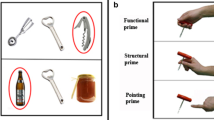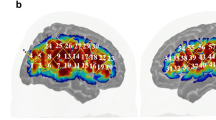Abstract
Motor behaviour is controlled by a large set of interacting neural structures, subserving the different components involved in hierarchical motor processes. Few studies have investigated the neural substrate of higher-order motor ideation, i.e. the mental operation of conceiving a movement. The aim of this functional magnetic resonance imaging study was to segregate the neural structures involved in motor ideation from those involved in movement choice and execution. An index finger movement paradigm was adopted, including three different conditions: performing a pre-specified movement, choosing and executing a movement and ideating a movement of choice. The tasks involved either the right or left hand, in separate runs. Neuroimaging results were obtained by comparing the different experimental conditions and computing conjunction maps of the right and left hands for each contrast. Pre-specified movement execution was supported by bilateral fronto-parietal motor regions, the cerebellum and putamen. Choosing and executing finger movement involved mainly left fronto-temporal areas and the anterior cingulate. Motor ideation activated almost exclusively left hemisphere regions, including the inferior, middle and superior frontal regions, middle temporal and middle occipital gyri. These findings show that motor ideation is controlled by a cortical network mainly involved in abstract thinking, cognitive and motor control, semantic and visual imagery processes.



Similar content being viewed by others
References
Bajaj S, Butler AJ, Drake D, Dhamala M (2015) Brain effective connectivity during motor-imagery and execution following stroke and rehabilitation. Neuroimage 8:572–582
Bernstein NA (1996) On dexterity and its development. In: Latash ML, Turvey MT (eds) Dexterity and its development. Lawrence Erlbaum Associates, Mahwah
Bolognini N, Convento S, Banco E, Mattioli F, Tesio L, Vallar G (2015) Improving ideomotor limb apraxia by electrical stimulation of the left posterior parietal cortex. Brain 138:428–439
Borra E, Belmalih A, Calzavara R, Gerbella M, Murata A, Rozzi S, Luppino G (2008) Cortical connections of the macaque anterior intraparietal (AIP) area. Cereb Cortex 18:1094–1111
Breveglieri R, Galletti C, Dal Bò G, Hadjidimitrakis K, Fattori P (2014) Multiple aspects of neural activity during reaching preparation in the medial posterior parietal area V6A. J Cogn Neurosci 26:878–895
Coubard OA, Urbanski M, Bourlon C, Gaumet M (2014) Educating the blind brain: a panorama of neural bases of vision and of training programs in organic neurovisual deficits. Front Integr Neurosci 8:89
Cunnington R, Windischberger C, Deecke L, Moser E (2002) The preparation and execution of self-initiated and externally-triggered movement: a study of event related fMRI. Neuroimage 15:373–385
De Renzi E, Lucchelli F (1988) Ideational apraxia. Brain 111:1173–1185
Drew T, Marigold DS (2015) Taking the next step: cortical contributions to the control of locomotion. Curr Opin Neurobiol 33:25–33
Dum RP, Strick PL (2002) Motor areas in the frontal lobe of the primate. Physiol Behav 77:677–682
Fried I, Mukamel R, Kreiman G (2011) Internally generated preactivation of single neurons in human medial frontal cortex predicts volition. Neuron 69:548–562
Friston KJ, Holmes AP, Price CJ, Büchel C, Worsley KJ (1999) Multisubject fMRI studies and conjunction analyses. Neuroimage 10:385–396
Frith C (1991) Positron emission tomography studies of the frontal lobe function relevance to psychiatric disease. Ciba Found Symp 163:181–191
Gao Q, Duan X, Chen H (2011) Evaluation of effective connectivity of motor areas during motor imagery and execution using conditional Granger causality. Neuroimage 54:1280–1288
Gardini S, De Beni R, Cornoldi C, Bromiley A, Venneri A (2005) Different neuronal pathways support the generation of general and specific mental images. Neuroimage 27:544–552
Gardini S, Cornoldi C, De Beni R, Venneri A (2006) Left mediotemporal structures mediate the retrieval of episodic autobiographical mental images. Neuroimage 30:645–655
Gardini S, Concari L, Pagliara S, Ghetti C, Venneri A, Caffarra P (2011) Visuo-spatial imagery impairment in posterior cortical atrophy: a cognitive and SPECT study. Behav Neurol 24:123–132
Grafton ST, Hamilton AF (2007) Evidence for a distributed hierarchy of action representation in the brain. Hum Mov Sci 26:590–616
Gross RG, Grossman M (2008) Update on apraxia. Curr Neurol Neurosci Rep 8:490–496
Hanakawa T (2011) Rostral premotor cortex as a gateway between motor and cognitive networks. Neurosci Res 70:144–154
Hécaen H (1972) Introduction à la neuro-psychologie. Librairie Larousse, Paris
Huey ED, Pardini M, Cavanagh A, Wassermann EM, Kapogiannis D, Spina S, Ghetti B, Grafman J (2009) Association of ideomotor apraxia with frontal gray matter volume loss in corticobasal syndrome. Arch Neurol 66:1274–1280
Ingvar DH, Philipson L (1977) Distribution of cerebral blood flow in the dominant hemisphere during motor ideation and motor performance. Ann Neurol 3:230–237
Koch G, Rothwell JC (2009) TMS investigations into the task-dependent functional interplay between human posterior parietal and motor cortex. Behav Brain Res 202:147–152
Lui F, Buccino G, Duzzi D, Benuzzi F, Crisi G, Baraldi P, Nichelli P, Porro CA, Rizzolatti G (2008) Neural substrates for observing and imagining non object-directed actions. Soc Neurosci 3:261–275
Mammarella N, Cornoldi C, Pazzaglia F (2004) Psicologia dell’apprendimento multimediale. Il Mulino, Bologna
Manuel AL, Radman N, Mesot D, Chouiter L, Clarke S, Annoni JM, Spierer L (2013) Inter- and intrahemispheric dissociations in ideomotor apraxia: a large-scale lesion-symptom mapping study in subacute brain-damaged patients. Cereb Cortex 23:2781–2789
Matelli M, Luppino G (2001) Parietofrontal circuits for action and space perception in the macaque monkey. Neuroimage 14:S27–S32
Matsuda I, Nittono H (2015) The intention to conceal activates the right prefrontal cortex: an event-related potential study. NeuroReport 26:223–227
Matsumoto R, Nair DR, Ikeda A, Fumuro T, Lapresto E, Mikuni N, Bingaman W, Miyamoto S, Fukuyama H, Takahashi R, Najm I, Shibasaki H, Lüders HO (2012) Parieto-frontal network in humans studied by cortico-cortical evoked potential. Hum Brain Mapp 33:2856–2872
Morawetz C, Bode S, Baudewig J, Kirilina E, Heekeren HR (2015) Changes in effective connectivity between dorsal and ventral prefrontal regions moderate emotion regulation. Cereb Cortex. doi:10.1093/cercor/bhv005
Olsson CJ, Nyberg L (2010) Motor imagery: if you can’t do it, you won’t think it. Scand J Med Sci Sports 20:711–715
Paivio A (1971) Imagery and verbal processes. Holt, Rinehart, and Winston, New York
Pellegrino G, Làdavas E (2015) Peripersonal space in the brain. Neuropsychologia 66C:126–133
Raffin E, Mattout J, Reilly KT, Giraux P (2012) Disentangling motor execution from motor imagery with the phantom limb. Brain 135:582–595
Rao SM, Binder JR, Bandettini BS, Hammeke TA, Yetkin FZ, Jesmanowicz A, Lisk LM, Morris GL, Mueller WM, Estkowski LD et al (1993) Functional magnetic resonance imaging of complex human movements. Neurology 43:2311–2318
Rizzolatti G, Fogassi L (2014) The mirror mechanism: recent findings and perspectives. Philos Trans R Soc B 369:20130420
Rizzolatti G, Luppino G (2001) The cortical motor system. Neuron 31:889–901
Schluter ND, Krams M, Rushworth MFS, Passingham RE (2001) Cerebral dominance for action in the human brain: the selection of actions. Neuropsychologia 39:105–113
Schulz KP, Bédard AC, Czarnecki R, Fan J (2011) Preparatory activity and connectivity in dorsal anterior cingulate cortex for cognitive control. Neuroimage 57:242–250
Shamay-Tsoory SG, Adler N, Aharon-Peretz J, Perry D, Mayseless N (2011) The origins of originality: the neural bases of creative thinking and originality. Neuropsychologia 49:178–185
Sharma N, Pomeroy VM, Baron JC (2006) Motor imagery: a backdoor to the motor system after stroke? Stroke 37:1941–1952
Simmons WK, Martin A (2009) The anterior temporal lobes and the functional architecture of semantic memory. J Int Neuropsychol Soc 15:645–649
Singer JL, Antrobus JS (1972) Daydreamer, imaginal processes, and personality: a normative study. In: Sheehan PW (ed) The function and nature of imagery. Academic Press, New York, pp 175–202
Tabibnia G, Creswell JD, Kraynak T, Westbrook C, Julson E, Tindle HA (2014) Common prefrontal regions activate during self-control of craving, emotion, and motor impulses in smokers. Clin Psychol Sci 2:611–619
Tanji J, Hoshi E (2008) Role of the lateral prefrontal cortex in executive behavioral control. Physiol Rev 88:37–57
Toma K, Nakai T (2002) Functional MRI in human control studies and clinical applications. Magn Reson Med Sci 1:109–120
Tomasino B, Rumiati RI, Umiltà CA (2003) Selective deficit of motor imagery as tapped by a left-right decision of visually presented hands. Brain Cogn 53:376–380
Waldvogel D, van Gelderen P, Ishii K, Hallett M (1999) The effect of movement amplitude on activation in functional magnetic resonance imaging studies. J Cereb Blood Flow Metab 19:1209–1212
Zimmer HD (2008) Visual and spatial working memory: from boxes to networks. Neurosci Biobehav Rev 32:1373–1395
Acknowledgments
This study was supported by funding from Fondazione Cassa di Risparmio of Parma and Piacenza and ex 60 % F.I.L. to P.C. and by a grant from MIUR (Italy) to A.V.
Author information
Authors and Affiliations
Corresponding author
Ethics declarations
Conflict of interest
All authors declare that they have no conflict of interest.
Rights and permissions
About this article
Cite this article
Gardini, S., Venneri, A., McGeown, W.J. et al. Brain Activation Patterns Characterizing Different Phases of Motor Action: Execution, Choice and Ideation. Brain Topogr 29, 679–692 (2016). https://doi.org/10.1007/s10548-016-0491-5
Received:
Accepted:
Published:
Issue Date:
DOI: https://doi.org/10.1007/s10548-016-0491-5




